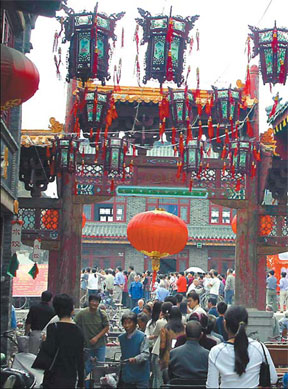
Zhoucun, once an ancient bustling town, is now a tourist destination in Shandong province.
Although it has been a town for hundred of years, Zhoucun, a jurisdiction of Zibo in Shandong province, is still called a village.
The town of 320,000 is known as the biggest "village" in China.
At 9 am every morning, the town awakes to sounding gongs. Several people, dressed in traditional Qing Dynasty (1644-1911) costume, parade along a narrow, stone-paved north-south road.
"It is an old custom passed on for hundreds of years," says Zhang Na, a local tour guide, adding it symbolizes smooth business.
According to history, earlier in the Ming Dynasty (1368-1644), Zhoucun was known for its handicraft industry and commerce. This eventually led the town to develop into an important marketplace in northern China in the Qing Dynasty. Emperor Qianlong praised it as the "No 1 Village in China".
Walking through its lofty alleys is like stepping back into the village's ancient business atmosphere.
The old taverns, antique shops, and painting and calligraphy stores all hold the architectural styles of the Ming and Qing dynasties. Flags and banners flutter in the wind as buildings of gray tiles and blue bricks stand tall on both sides of the main street.
"It is rare to see such a well-kept ancient fair in north China," says Wang Zhigang, a reporter from Hong Kong-based Ta Kung Pao.
Zhoucun also used to be a famous inland harbor, known for all the goods found within this village without a canal.
With one of the oldest free trade zones in Chinese history, its favorable tax policy lured businessmen across the country. In its prime, the village had over 5,000 shops and firms.
A monument at the crossroad of the main street is inscribed with the words "free of tax" - to encourage business development.
The slurry-dye industry was the village's main business in the late Ming Dynasty, when the town held over 40 slurry mills and more than 70 dyeing mills.
The Dong Lai Sheng silk store - filled with ancient spinning wheels, weaving machines, a dye tank and piles of colorful cloth - was one of the biggest stores in the village.
Today, there are still many shops on Silk Street that sell fine silks and cotton cloth.
After the Opium War (1839-1842), businessmen from Shanxi, Guangdong, Guangxi and Fujian were drawn to the village for its potential. Customers came from home and abroad - hailing from Russia, Japan and India.
"So, it was said the little street made greats amount of money," says Zhang.
According to historical records, a large number of bills and coins used in its ancient banks demonstrated the village's rising, development and prosperity.
"In 1921, the number of large scale exchange shops rose to 108 with total assets of 6 million taels of silver," says Zhang.